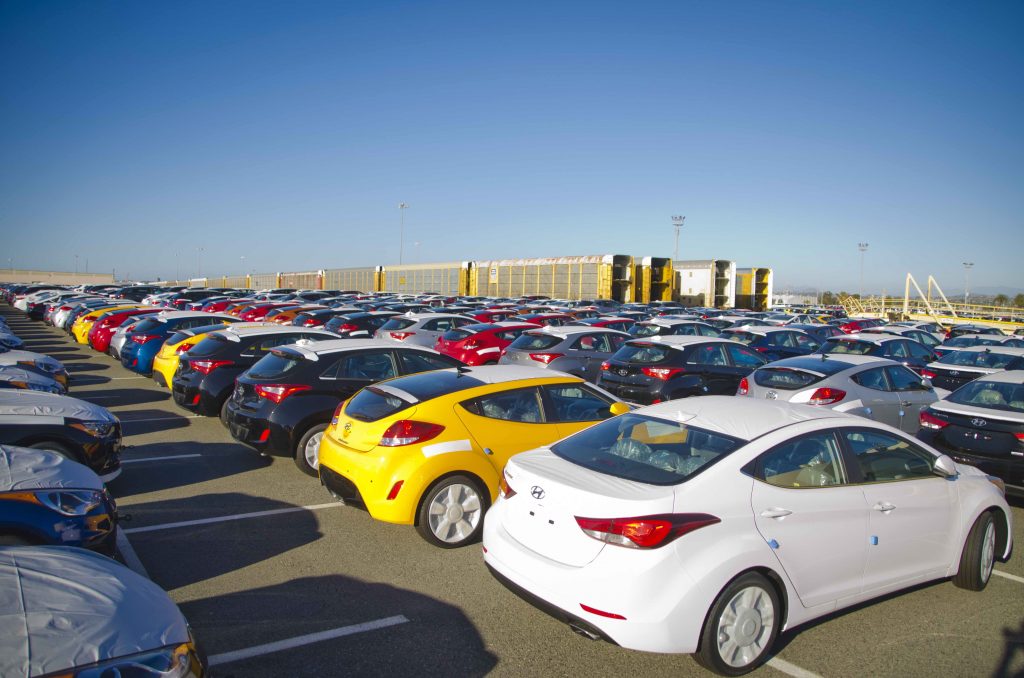 [sta_anchor id="1"]Our annual survey found most ports are seeing strong imports across North America, leading (in some cases) to parking constraints and vessel bunching. The future may look different, but operators and OEMs need to get smart about space
[sta_anchor id="1"]Our annual survey found most ports are seeing strong imports across North America, leading (in some cases) to parking constraints and vessel bunching. The future may look different, but operators and OEMs need to get smart about space
Our survey of North American ports for 2015 confirmed partly what we already knew: with record light vehicle sales across the region, last year was a banner year for the vehicle trade. What may be surprising is that, despite rising regional production in the US and North America, imports have grown so strongly, including those by deep sea and, to a lesser extent, sea trade between Mexico and the US. Production capacity expansion within the US and Mexico could well change this demand pattern over the coming years, however for now the growth in imports has led to age-old problems of vessel bunching, limited yard space and other capacity constraints at vehicle-handling terminals.
Across 29 ports that participated in the survey, the number of new light vehicles handled increased from 6.65m units in 2014 to 7.33m last year, growth which was driven by a 15% increase in imports. Exports, meanwhile, fell by around 2%, hurt by a strong dollar and weakness in some global markets.
In this story...
Baltimore’s developments were the result in part of changes to OEM flows. FCA, for example, is now shipping exports to the Middle East from the port of Wilmington, Delaware – flows that used to move out of Baltimore. Likewise, the carmaker has actually seen its overall exports from the US decline as it has increased Jeep production in global markets including Europe, China, India, Brazil and, soon, Mexico. On the other hand, it started building the Jeep Renegade last year in Italy and importing the model in fairly large numbers to the US and Canada.
Such changes are a reflection of the complexity of vehicle flows and how they shift. Baltimore also offers examples of how they might evolve further. The port has benefitted from Mexican imports by short-sea, which accounts for 15% of the total volume for 2015, a growing percentage of its overall new vehicle flow, according to Larry Johnson, head of trade development for automotive at the port of Baltimore. The port currently handles seven OEMs that use short-sea services from Mexico, including Ford, Nissan, Mazda and General Motors. Johnson expects a volume increase from Mexico of 5-10% in 2016.
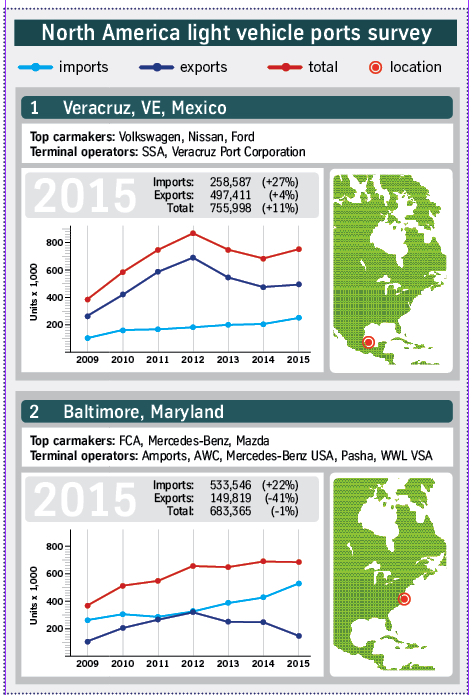 Mexican volumes look set to become more important over the medium term and beyond, both for global and regional exports, with expectations that output in the country will increase by around 50% to 5m units by 2020. Already this year, Kia and Audi will start shipping vehicles from Mexico, while others will join or increase in coming years including BMW, Mercedes-Benz and Toyota. Other brands including Ford, Nissan, General Motors and Fiat Chrysler are all planning to expand or in the process of expanding their current output, with a huge share of the capacity targeted for the US and Canadian markets.
Mexican volumes look set to become more important over the medium term and beyond, both for global and regional exports, with expectations that output in the country will increase by around 50% to 5m units by 2020. Already this year, Kia and Audi will start shipping vehicles from Mexico, while others will join or increase in coming years including BMW, Mercedes-Benz and Toyota. Other brands including Ford, Nissan, General Motors and Fiat Chrysler are all planning to expand or in the process of expanding their current output, with a huge share of the capacity targeted for the US and Canadian markets.
For 2015 and this year, however, the major story for Mexico has actually been strength in vehicle imports, which grew a remarkable 37% during 2015 across the six Mexican ports in our survey. Imports to Mexico have remained strong in 2016 as well. The growth has been led by deep-sea trade out of Asia, in particular India, as Mexican consumers buy more economical, subcompact cars even as their North American cousins in the US and Canada move even more towards SUVs, crossovers and pickup trucks.
The port of Veracruz, which saw its imports rise by around a quarter, returned to the top of the survey table after several years in second place. On the other hand, Mexico’s ports actually saw a decline in exports overall, hurt, in part, by the diesel scandal at Volkswagen – as many affected models are built in Mexico – as well as the decline in sales for small cars that are often built south of the border. Rising volume overall in Mexican ports nevertheless puts focus on the importance of infrastructure improvements and efficiency measures – issues facing a number of North American ports.
[sta_anchor id="2"]Imports lead the wayThere were many instances of strong growth across the North American network. Notable increases could be found in south-eastern ports. Jacksonville, for example, had a strong year, handling more than 671,000 new light vehicles in 2015, an increase of nearly 14% over 2014’s figures. The rise may largely be attributed to the addition of Volkswagen and Porsche in mid-year 2015, which switched to the port from Brunswick, as well as the strong US market. Jacksonville has also begun to import FCA vehicles from Italy, according to Frank Camp, director of non-containerised sales. Camp predicts that although rail will continue to handle the majority of Mexican exports to the US, more cars will move by short-sea as volume increases. The port now handles seven to eight monthly sailings from Mexico, through Volkswagen-chartered vessels, K-Line, Höegh Autoliners and NYK Line.
At Volkswagen Group of America, Mark Boucher, general manager for vehicle logistics, says that moving to Jacksonville has helped the carmaker meet demand faster. “Our reasons for switching include being closer to our markets,” he explains. “Other reasons are the size and structure of the layout and, of course, economics.”
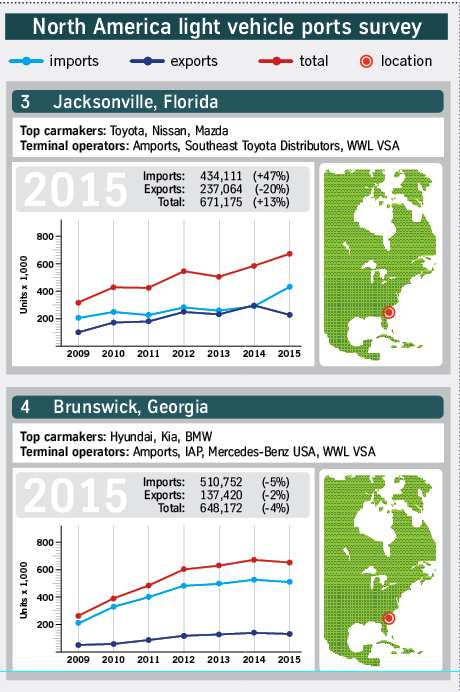 Over the next year, Volkswagen will begin shipping the Audi Q5 crossover and the VW Tiguan SUV by rail from Mexico to the ports of San Diego and Houston as it ramps up production in San José Chiapa and Puebla. It also ships to the ports of Jacksonville and Davisville by short-sea from Mexico, which should lead to further growth at sea.
Over the next year, Volkswagen will begin shipping the Audi Q5 crossover and the VW Tiguan SUV by rail from Mexico to the ports of San Diego and Houston as it ramps up production in San José Chiapa and Puebla. It also ships to the ports of Jacksonville and Davisville by short-sea from Mexico, which should lead to further growth at sea.
The port of Brunswick, meanwhile, saw a small decline overall in its volume, partly as a result of Volkswagen and Porsche moving to Jacksonville. Volumes increased, meanwhile, from Europe, South Korea and Mexico to offset a portion of this loss, according to Bill Jakubsen, global manager for ro-ro, bulk and general cargo at the Georgia Ports Authority. Jakubsen predicts higher imports from Europe and Japan this year as well as an increase in short-sea units from Mexico.At the port of Charleston, Jack Ellenberg, senior vice-president of economic development and projects, says that manufacturing growth in the south-east is a significant trend driving the port’s volumes. Amidst this growth, Mercedes-Benz announced plans last year to begin full production of Sprinter vehicles at a new plant that will be built in Charleston. Furthermore, Volvo Cars recently broke ground on its first US plant just outside of Charleston. Exports also continue to rise with BMW’s expanded production at its Spartanburg, South Carolina plant.
To accommodate its growing Mexican imports, the port of Charleston recently gained a weekly vessel call by K-Line’s South America service. The rotation includes the ports of Veracruz, Altamira, Jacksonville and Charleston, as well as ports in Central and South America.
Overall, ports in south-eastern states saw import growth of around 17% last year, rising to more than 1m units.
In the south-west, meanwhile, there was also a significant rise in imports, expanding by around 9% across ports in California to reach 1.38m units. Although this was led by the port of San Diego, the port actually saw a decline overall following drops in imports from Volkswagen out of Mexico (these volumes were mostly compensated for by a surprising growth in exports, however).
Stronger import growth was actually seen further north at the port of Hueneme, California. The port handled more than 338,000 new vehicles last year – an increase from under 300,000 units in 2014, making it the ninth-ranked port overall. John Demers, chief operations officer, predicts continued growth in 2016.
“We are also handling a new line of exports, mostly to Korea but also to Japan and China,” he says. “We import a lot from Korea and are taking advantage of the existing synergy.”
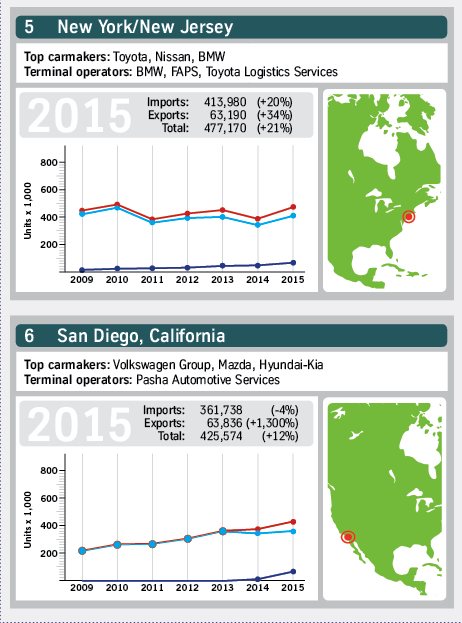 The port of Los Angeles, which handles Nissan vehicles, grew by more than 30% last year thanks to a rise in imports of the Nissan Rogue from Japan and South Korea. In 2016, the port expects another 10% rise to 180,000 units, says Marcel van Dijk, manager cargo marketing at the port.
The port of Los Angeles, which handles Nissan vehicles, grew by more than 30% last year thanks to a rise in imports of the Nissan Rogue from Japan and South Korea. In 2016, the port expects another 10% rise to 180,000 units, says Marcel van Dijk, manager cargo marketing at the port.
[sta_anchor id="3"]Recovery in the northIn north-eastern ports, which collectively represent the most vehicle-handling across North America, strong imports at major hubs like Baltimore and New York/New Jersey propelled volume to its highest level for years. Across ports in this region, imports rose by around 18% to reach nearly 1.47m units. At the port of New York/New Jersey, imports rose 20%, led by Toyota, Lexus, BMW and Nissan.
On the New England coast, the port of Davisville, Rhode Island handled more than 227,000 new vehicle imports last year, an increase of more than 27% over 2014’s figures. Evan Matthews, port director, says that part of this growth was because the port of Halifax, Canada declared force majeure amidst icy waters, diverting a number of vessels carrying Volkswagen Group vehicles to Davisville.
Also, when Volkswagen Group switched from the port of Brunswick to Jacksonville last year, the move further south made a northern port of call more likely for some regions. “For example, we have handled volumes for states from Maryland south to North Carolina,” he says.
The port of Philadelphia, which serves Hyundai and Kia imports, also handled a record 156,000 units last year.
Meanwhile, Baltimore is expected to see further volume rises, including some recovery in exports. “We are seeing a lot of good signs for exports this year, including exports of the Mercedes-Benz R-class to China,” says Larry Johnson. “Imports should also remain high for us; in particular, Volvo, Mitsubishi and Jaguar Land Rover are very strong.”
The Pacific north-west experienced the weakest growth of any North American sub-region last year, mostly because of a fall in exports of around 22%. Ports such as Grays Harbor, Washington, which has been an important export centre for FCA, saw its export volumes decline by around a third following a drop-off in shipments to Asia and China. The port of Portland, meanwhile, which has become a hub for Ford exports to Asia, had more stable export volume, nudging up by 2%.
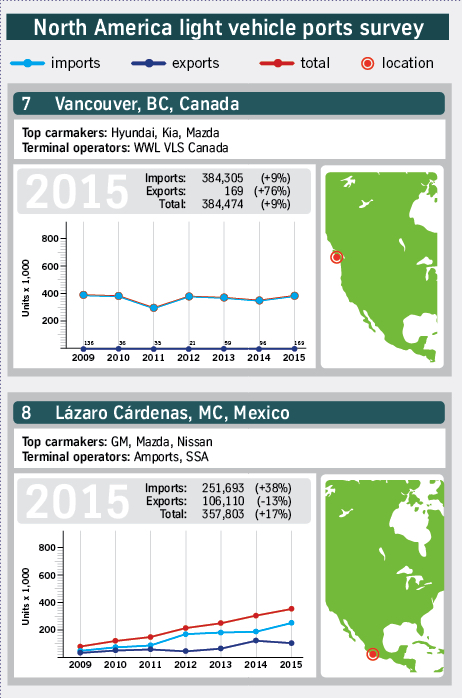 However, even in this less populous region, imports grew steadily. At the port of Vancouver, Canada, new vehicle imports of more than 384,000 units were the highest since 2009, with a 9% increase over 2014. Canadian sales reached a new record in 2015, which included a strong growth in demand for light trucks and a sharp shift in demand away from passenger cars, according to port spokesperson Julia Ren. Its primary imports are from Japan and Korea.
However, even in this less populous region, imports grew steadily. At the port of Vancouver, Canada, new vehicle imports of more than 384,000 units were the highest since 2009, with a 9% increase over 2014. Canadian sales reached a new record in 2015, which included a strong growth in demand for light trucks and a sharp shift in demand away from passenger cars, according to port spokesperson Julia Ren. Its primary imports are from Japan and Korea.
“We were expecting flat volumes or a slight decline due to the state of the Canadian economy and adjustments madeby our customers to the shifting market, but Canadian sales are still rising towards another record level so far in 2016,”she says.
The port of Tacoma, which handled a record 183,000 units last year, is cautiously optimistic about its 2016 volumes, according to Andre Elmaleh, senior manager, business development for non-container, who says that volumes are up 9% through April.
At the port of Vancouver, Washington, Subaru signed a lease extension of its partnership with the port until at least 2030. Subaru’s imports at the port grew to 90,183 vehicles in 2015 – a 10% increase over 2014, says Alastair Smith, chief marketing and sales officer. It expects further growth in 2016.
[sta_anchor id="4"]Issues of spaceThe growth in imports over the past year has put strains on terminal capacity at a number of ports, leaving port processors and OEMs scrambling to find additional parking and handling space. Pasha Automotive Services, for example, has seen its average vessel discharge increase from approximately 1,500 vehicles per port call up to 2,500 or more units, according to Brian Mason, vice-president of planning, analysis and development. He reveals he is on a constant search for extra or temporary space; in San Diego, for example, Pasha has recently started using the parking lots at SeaWorld during the winter.
Pasha has seen slower overall vehicle velocity, as well as vessel bunching periods that contributed to increased average daily inventory at terminals. “Volume that could have been supported efficiently with intervals between vessel arrivals were less efficient with multiple vessel arrivals on the same day,” says Mason.
Mark Boucher says that Volkswagen, which rails vehicles from Mexico to San Diego, also noted the space constraints in southern California. “In mid-2015, we began struggling at the port of San Diego. We need to wait for vessel berth space – there are also clogs for rail and truck space. Delays last two to three days, on average. This problem has been a steady one since the fourth quarter of last year,” he reports.
By contrast, says Boucher, the port of Houston, which also receives imports from Mexico by rail, has coped better with volume.
 Despite the space issues, Mason says Pasha has largely been able to accommodate the growth. “On several occasions, while other US west coast ports were completely full, Pasha was able to accept increasd vessel volumes at the ports of San Diego and Grays Harbour [Washington],” he confirms.
Despite the space issues, Mason says Pasha has largely been able to accommodate the growth. “On several occasions, while other US west coast ports were completely full, Pasha was able to accept increasd vessel volumes at the ports of San Diego and Grays Harbour [Washington],” he confirms.
Likewise, 2016 is off to a great start for San Diego, with strong monthly arrival volumes in the year to date. According to Mason, Pasha’s average marine inbound arrivals for 2016 in the port are 36,700 units per month.
“We have seen the greatest increase in short-sea from Mexico at our San Diego facility, which is the closest US west coast auto terminal with complete vehicle processing, as well as significant on-dock rail capacity,” he says. “The increase in short-sea volume appears to be driven by OEMs who have had challenges with rail from Mexico plant origins, or who prefer short-sea ocean shipping for their vehicles.”
Other ports and terminal operators have seen congestion. “Dwell times were trending slightly higher last year compared to the two previous years,” says Sean Mahoney, director of marketing at the port of Philadelphia. This trend may require future adjustments in infrastructure or port processes to maintain the most efficient flow, he added.
Auto Warehousing Company (AWC), which operates port terminals on both coasts, has also seen constraints resulting from volume surges, according to director of sales and marketing Mark Berg.
“Whether it is back-to-back vessel arrivals with large volumes or the lack of car haulers or the right railcars, volume surges create the need for overflow yards, off-site storage and other alterations to established processes,” says Berg.
He points out that earlier this year on the east coast, one manufacturer was averaging a 22-24 day dwell time as recently as April. The dwell time has been reduced to an average of ten days by smoothing out the incoming volume and adding additional outbound carriers.
Berg says that AWC is able to set priorities as to which vehicles are received when it helps to even out the flow and create a more efficient process. “Furthermore, working with our rail partners, we have been able to improve the inbound and outbound railcar flows in areas such as unloading and reloading railcars in the same day,” says Berg. “On the west coast, we have improved our communication with rail partners on inbound vehicles, allowing us to stage them at the rail yard and control the flow of vehicles to match vessel departures.”
A WC has also developed pre-advices via ASNs (advanced shipping notices) to identify vehicle options, destinations and the final mode of transportation.
WC has also developed pre-advices via ASNs (advanced shipping notices) to identify vehicle options, destinations and the final mode of transportation.
“Our system enables us to identify which bay the unit is in to the trucker in advance. Through messaging prior to the vehicles’ arrival,we coordinate processing and pickup,” he says. “This helps to establish a flow, diminish volume bubbles and avoid delays caused by holds or lack of correct equipment.”
[sta_anchor id="6"]Terminal investmentThe growth in vehicle handling across North America has led to a number of new investments, both at existing terminals and in terms of new gateways for finished vehicle trading. Mainstay ports, in particular, continue to invest in expanding capacity. Brunswick is addressing vessel dwell time by adding more pavement, for example. Its rail trackage also increased by more than 8,700ft (2,650 metres), which will provide more capacity for vehicle handling.
The port of Vancouver, meanwhile, recently completed a trench structure as part of the West Vancouver Freight Access project – a decade-long initiative costing $275m that will more than triple the port’s rail capacity, reducing delays in rail traffic by as much as 40%, according to Alastair Smith.
New facilities are also emerging. An important new player is Höegh Autoliners’ new processing subsidiary, Horizon Terminals. Since July 2015, Horizon has been providing vehicle and equipment processing at the ports of Freeport, Texas, located near Houston, and Port Everglades, Florida. The Freeport facility became operational last November. It will export 80,000 units and import 20,000 this year, according to Per Folkesson, president of Horizon Terminals.
Freeport also handles a substantial percentage of high-and-heavy equipment. Its equipment processing centre provides assembly services for imported machinery that comes with separate attachments, for example. Folkesson points out that with Freeport, the automotive industry can import vehicles closer to the end market instead of hauling them from either the west or east coasts. Previously, Höegh was using Galveston for used vehicles and machinery. However, Folkesson says Galveston had a high degree of contamination and the infrastructure was lacking in quality.
Nevertheless, WWL has recently completed a new vehicle terminal for BMW at Galveston, further expanding the role of the US Gulf coast for vehicle handling. Galveston, which is located 45 miles (70km) south of Houston, is providing capacity and terminal services, and expects around 32,000 units of BMW and Mini vehicles from Europe and South Africa this year, says John Peterlin, senior director of marketing and administration.
Like Freeport, Galveston handles new and used high-and-heavy equipment, including exports to South America, East Asia and Europe. “Remarketed exports have slowed since oil prices dropped,” admits Peterlin.
According to John Felitto, president and chief executive of WWL Vehicle Services Americas, the vehicle processing centre, which opened in late April, is designed to handle 30,000-40,000 units per year, but could scale up to 60,000.
Meanwhile, in southern Florida, Horizon’s facility in Port Everglades, which Höegh acquired together with an ocean service in the Caribbean from SC Line, is geared toward new and used vehicles and machinery exports to the Caribbean and Central America as well as trade between Mexico and the US. A vehicle processing centre is in the works, but not yet available.
Pasha also plans to open new port processing facilities in 2016, including the San Francisco Pier 80 Terminal and the Trade Point Atlantic Terminal at Sparrows Point, near the port of Baltimore; this is a private terminal on the site of a former steel mill that will handle FCA imports from Europe. Pasha already operates at Dundalk Marine Terminal in Baltimore. It has been experiencing strong growth on existing routes from Europe, South Korea and Japan.
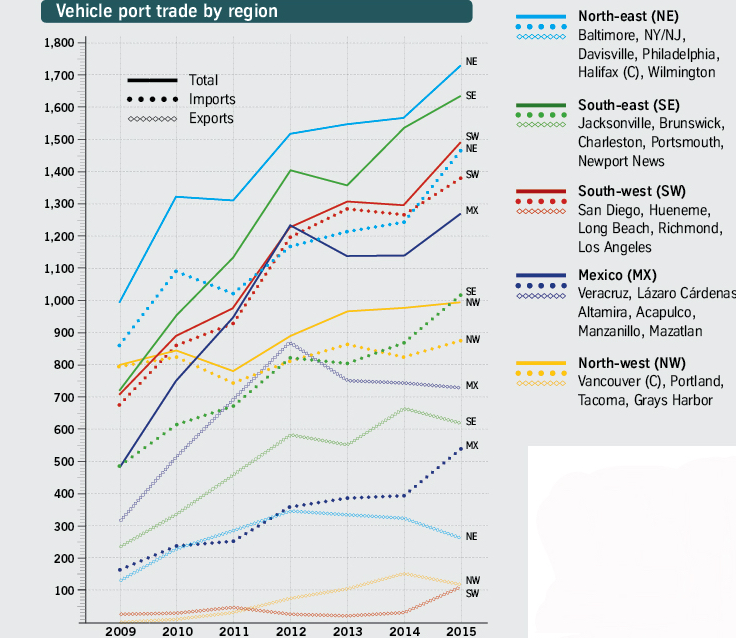 “We are actively pursuing adding service to additional routes, including Australia,” says Mason.
“We are actively pursuing adding service to additional routes, including Australia,” says Mason.
[sta_anchor id="7"]Mexican promiseWhile Mexico’s vehicle trade with the US by sea is perhaps still not exploding with growth, there are signs of increasing activity. Höegh, for example, ramped up its presence in Mexico by adding two sailings per month from the ports of Veracruz and Altamira to Port Everglades early this year. These routes incorporate new connections, including the ports of Cartagena, Colombia; Vigo, Spain; and Newcastle, UK. Tomasz Lis, head of area Latin America, says that its shipments are mostly new cars but also include trucks and high-and-heavy project equipment.
In Mexico, Lis points out that the port of Lázaro Cárdenas lost some volume last year to Manzanillo and Mazatlan, the latter of which Ford is starting to use for exports. The change resulted from contamination problems in Lázaro and safety issues in the area surrounding it, including theft and vandalism during rail transport to the port, claims Lis.
“Until the new car terminal opens outside of contamination areas, which would take about two years, the smaller ports will take market share from Lázaro Cárdenas,” he says. “This also includes Acapulco, located south of Lázaro Cárdenas, which has seen increased exports to Central and South America.”
Lázaro Cárdenas still remains important to Mexico’s import and export network. Audi will use it for exports to Asia and potentially to the US west coast, for example. SSA Mexico has resolved issues over a concession and will begin major investments later this year in a new car terminal there. And with more manufacturers adding capacity and increasing their export plans from Mexico, more of that investment is likely to follow across other ports in the country.



































